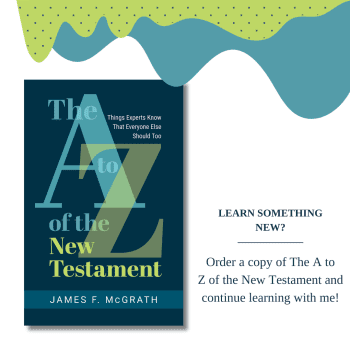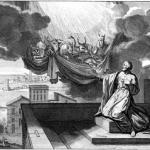Chapter 7 of Earl Doherty’s book Jesus: Neither God Nor Man
turns attention to other characters in the Gospels and events that are not mentioned about them in the epistles: Judas’ betrayal and Peter’s denial, for starters.
Presumably the first thing to note it that the latter completely undermines Doherty’s argument. Paul refers to encounters with Peter – a real historical individual – and thus if he can be a real individual without stories from the later Gospels appearing in the epistles, then clearly so can Jesus.
Beyond that, it seems as though Doherty thinks that recent events should have had the same status for members of this Jewish sect as their Scriptures did. Otherwise, it isn’t clear why recent events should have been chosen to illustrate points when Scripture carried more weight.
As for why Paul doesn’t accuse Peter of denying Jesus three times (a question Doherty raises), presumably Peter could have responded with “and how many times did you persecute Christians?” If they were inclined to have that conversation, it is entirely possible that they had got it out of their system before Galatians was written, and that Paul thought better about starting it up again.
Doherty mentions Q and the Gospel of Thomas as sources that show no awareness of Jesus’ death, and seems to think that this too is evidence for mythicism. We may leave Thomas to one side given the ongoing debates about it’s date and interpretation, but as for Q, unless one is adopting the Christian view that the risen Jesus taught the apostles after Easter, then precisely what sort of discussion of his death should we expect in a source that preserves Jesus’ teaching?
If, in his book, Doherty were trying merely to show that the Jesus of today’s popular Christianity is not the historical Jesus, some of his points might carry some weight – and would agree with mainstream scholarship. But time and again he seems unaware of one essential point: You cannot disprove or even intelligently discuss the existence of the historical Jesus unless you adopt historical methods. Let me give a few examples of the kinds of things Doherty addresses in a manner that ignores relevant scholarly or historical considerations:
He mentions the absence from the epistles of Jesus’ words from the cross, “Father forgive them, for they know not what they do,” apparently unaware or unconcerned that that saying is judged on text-critical grounds to be unlikely to be an original part of Luke, to say nothing of whether any disciple could have heard anything Jesus said on the cross. The words attributed to Jesus on the cross may have been felt by the Gospel authors to be appropriate to the person and the occasion, but a historian will have serious doubts about their authenticity. Doherty discusses in much the same fashion the trial of Jesus, Pilate’s hand-washing, the earthquake, darkened heavens and the torn veil (pp.74-75). Even some relatively conservative historians have recognized that there are reasons to question the historicity of such details. If Doherty is not going to apply the insights and methods of historical criticism, or at least engage the arguments of historians that these are likely to be legendary and symbolic details, how can he possibly expect anyone to take his arguments seriously as history?
On a more substantial underlying point, I have the strong impression that Doherty has given little thought to what is involved in turning a tradition into a narrative. We may start with a more recent example. If someone had information about the assassination of John F. Kennedy only by the means available in New Testament times – word of mouth – or even via newspapers, and they wanted to turn what they knew from such reports into a story – let’s say a movie – then imagine just how much dialogue, how many supporting characters, how many undocumented events the person would have to concoct in order to accomplish that. In the same way, imagine two authors who received a tradition like that in 1 Corinthians 15, and the different ways they might try to turn it into a story – for instance, we might find one setting an event in Jerusalem, the other setting the same event in Galilee, since the location wasn’t specified. That is in fact what we find in the Gospel Easter stories, and such huge discrepancies at such a major juncture can seem genuinely puzzling – until we realize that in passing on information, we do not always provide enough detail so as to enable the listener to later reproduce it as a narrative. This is one of the reasons why accounts of historical events need to be subjected to historical critical analysis, and why the discovery that many details may be authorial flourishes doesn’t mean that there may not at the same time be important kernels of historical information wrapped in them.
Now for a major point of agreement between Doherty and myself. I think he is right that the author of the Letter to the Hebrews does not leave any room in his system of thought for a physical bodily resurrection of the sort that other New Testament writings envisage. The author of Hebrews has Jesus offer his sacrifice and take it into the celestial Holy of Holies to purify the sanctuary, so as to allow a holy God and impure humans to dwell together, as the Aaronic priest was commanded to do on the Day of Atonement. Envisaging Jesus offering his life as a sacrifice, waiting, picking up his body a couple of days later, and then heading to heaven to present his sacrificial death after he had ceased to be dead turns Hebrews’ already cumbersome system into one that is grotesque. The author’s Platonic outlook would fit well with a view of heaven that does not require or allow for an earthly or physical body to be brought there. Nevertheless, since the whole outlook of Hebrews is distinctive among the New Testament writings, I am inclined to view this as one Platonically-influenced author’s idiosyncratic take on Jesus, rather than an indication of the original worldview of Christians, from which the rest of the New Testament authors managed to drop the key distinctive elements.
Having finally found some pages with some legitimate and helpful insights, one might hope that the book is turning in a better direction. If you do so at this juncture, you will be disappointed, as I was. The next section discusses the references to Jesus “appearing” or “being seen,” and the likelihood that these refines are to visions rather than physical experiences. Doherty interacts with Eddy and Boyd, who point out that resurrection in Judaism meant something bodily. Doherty writes in response, “While the latter claim may be correct, such expectation lay within the context of resurrection for humans, not of a god – and of humans on earth, not of a god in a supernatural location” (p.77).
A reader familiar with Jewish beliefs from this period – and with the act of reading – will most likely simply shake their head at this attempt to avoid the significance of contextual evidence rather than make sense of Paul in light of it. What god is Doherty referring to? What resurrection of non-humans from the dead? Where are these ideas found in Judaism? What is the evidence that such language would have been understood by Paul’s hearers in the way Doherty imagines? There is none, outside of Doherty’s own admittedly creative imagination.
What Doherty does here is to completely reverse the appropriate direction of reasoning. When we interpret an individual text, we look at its context and other texts from the same milieu in order to have a basis for determining the meaning of the individual text under discussion. Instead, Doherty determines what he wants Paul to mean, and then dismisses the counter-evidence by coming up with other possible meanings and references, no matter how contextually implausible, and using them to avoid the likely meaning of Paul’s words in his time and place.
If we are allowed to just make stuff up, then Doherty is free to do so, but so are others, and there is no basis for him to criticize any other meanings that some might attribute to these texts. If, on the other hand, we take the accepted understanding of language, culture and communication, and think it is possible to determine what texts mean against the background of a particular linguistic, cultural and historical context, then Paul meant what the words he used meant in that time and place, unless he indicates otherwise, in which case Doherty is simply wrong and unwilling to admit it. But because Doherty has not committed himself to the norms of scholarly (or even typical human) textual analysis, Paul ends up meaning things that his contemporaries would not have understood, and evidence that the words Paul uses meant something other than what Doherty wishes them to will be met with seemingly infinite creativity.
The remainder of the chapter includes arguments that for Paul, the resurrection of Jesus was “a matter of faith, not of historical record as evidenced by eyewitness to a physical, risen Jesus at Easter” (p.79). Since Doherty has already accepted the argument of the Jesus Seminar and other scholars that the earliest “Easter experiences” were of a visionary sort, it is unclear why he thinks it would be persuasive to argue a point in relation to a more physical understanding of resurrection. The visionary nature of the experiences that persuaded those early Christians that Jesus had been raised from the dead is compatible with (and a result of some) mainstream scholarship, and so trying to pretend the point is not merely compatible with mythicism but somehow serves as an argument in it’s favor is disingenuous.
Doherty’s repeated assertions that Paul did not depend on apostolic tradition perhaps shows how persuasive Paul’s apologetic for his own authority in Galatians is, but does nothing to make Doherty’s interpretation persuasive. Derivative tradition still works as a historical explanation, in a way that supernatural visions or divinely-guided revelations from Scripture, which supposedly led Paul and other apostles to the same Gospel, do not.
The chapter closes with some lame attempts at psychologizing, which may resonate with some Christians more than with others. Wouldn’t Paul have wanted to stand before the empty tomb? And having done so, wouldn’t he want to write about it to churches? Wouldn’t he want to carry around a crucifixion nail, boast of having it, and perhaps rub it on his epistles and then mention in the letter that he had done so? OK, I’m parodying what Doherty wrote in that last one, but you get the idea. Doherty should at least entertain the notion that the earliest Christians may not have held the same cultural norms and interests as those in the Middle Ages. But even if Doherty is right in his psychologizing, that doesn’t provide a reason for preferring mythicism to other possibilities. Let’s say Paul had a fragment of the true cross that he always carried with him. Why would he wait until some later time when he wrote to a group of Christians to boast about it? Why wouldn’t he mention it and even show it off to them on his first encounter with them? Even if Doherty has psychoanalyzed Paul and the other early Christians correctly with respect to the importance of pilgrimage sites and relics, there are plenty of non-mythicist scenarios which are no more speculative and no less plausible than the one he suggests. The possibility that belief that the end of history was drawing near might make pilgrimages and acquisition of relics seem less important is just one factor among many that ought to be considered.
Since I have already made the point that it is reckless to expect ancient people to think and behave like modern ones, and to psychologize about them without at the very least studying anthropological and sociological studies relevant to possible differences between us and them, I won’t say more about that here.
In this chapter,as elsewhere, Doherty keeps going on about the lack of tales of the historical Jesus in the epistles. He has yet to explain the absence of mythical tales. If we should expect stories in letters, we should expect them on both mythicist and historicists scenarios. If that is not a fair expectation, then their absence doesn’t tell against either one.
This brings us to the end of Part Two of Doherty’s book, and so it may be time for another recap soon. Thus far, we have seen that there are some places where mythicism could work as an interpretative option, and others where it simply does not. In the latter instances, Doherty offers unconvincing, speculative, ad hoc arguments for why readers of his book should not follow the evidence where it more naturally leads. I hope that readers will see those for what they are, and choose to follow the evidence rather than Doherty’s imagination.

















